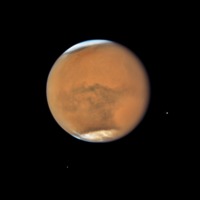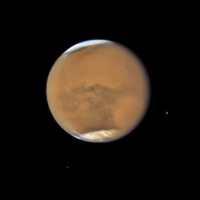Mars Opposition 2018
Dublin Core
Title
Subject
Description
ABOUT THIS IMAGE
Hubble’s Close-up View of Mars Dust Storm
NASA’s Hubble Space Telescope photographed Mars on July 18, near its closest approach to Earth since 2003. The planet was observed near opposition, when the Sun, Earth and Mars are lined up, with Earth sitting in between the Sun and Mars. This proximity gives the Red Planet its brightest appearance in the night sky since the 2003 opposition.
It’s springtime in Mars’ southern hemisphere, where a dust storm erupted and ballooned into a global event that is now blanketing the entire planet. Even so, several distinctive features can be identified.
The large oval area at the lower right is the bright Hellas Basin. About 1,400 miles across and nearly five miles deep, it was formed about 4 billion years ago by an asteroid impact. Many global dust storms originate in this region, the deepest feature on Mars.
The orange area in the upper center of the image is Arabia Terra, a vast upland region in northern Mars that covers about 2,800 miles. The landscape is densely cratered and heavily eroded, indicating that it could be among the oldest terrains on the planet.
South of Arabia Terra, running east to west along the equator, are the long dark features known as Sinus Sabaeus (to the east) and Sinus Meridiani (to the west). NASA’s Mars rover Opportunity landed in the western portion of Sinus Meridiani, while its twin, Spirit, landed on the other side of the planet.
The darker regions of Sinus Sabaeus and Sinus Meridiani are covered by dark bedrock and fine-grained sand deposits ground down from ancient lava flows and other volcanic features. These sand grains are coarser and less reflective than the fine dust that gives the brighter regions of Mars their rusty appearance.
Because it is autumn in the northern hemisphere, a bright blanket of clouds covers the north polar region. Clouds also can be seen over the southern polar cap.
The two small moons of Mars, Phobos (right) and Deimos (left), appear in the lower half of the image.
This picture of Mars was captured on July 18, at just 36.9 million miles from Earth, near its July 27 opposition. The biennial close approaches between Mars and Earth are not all the same. Mars’ orbit around the Sun is markedly elliptical; the proximity to Earth can range from 35 million miles to 63 million miles. Data from Hubble and the missions studying Mars will provide greater insight into the processes that cause the Martian dust storms.
Oppositions occur because about every two years Earth’s orbit catches up to Mars’ orbit, aligning the Sun, Earth, and Mars in a straight line, so that Mars and the sun are on “opposing” sides of Earth. This phenomenon is a result of the difference in orbital periods between Earth’s orbit and Mars’ orbit. While Earth takes the familiar 365 days to travel once around the Sun, Mars takes 687 Earth days to make its trip around our star. As a result, Earth makes almost two full orbits in the time it takes Mars to make just one, resulting in the occurrence of Martian oppositions about every 26 months.
ABOUT THE OBJECT
Object Name:
Mars
Object Description:
Planet
Distance:
On July 18, 2018, Mars was 0.39 astronomical unit (37 million miles or 59 million kilometers) away from Earth.

